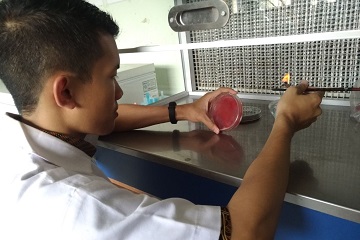IPB Students Utilize Coconut Husk for Haematuria Detection

Three students of Bogor Agricultural University (IPB) contributed in healthcare innovation. Those three are Ahmad Irvan Pratama, Dina Istiqamah, and Neng Shinta Noveria Aska from the Department of Biochemistry, Faculty of Mathematics and Natural Sciences (FMIPA) IPB. They designed a haematuria detector called Biotra (Haematuria-Based Biosensor-Based Hematoxase Enzyme from Streptococcus agalactiae as Early Detection of Haematuria). The detector designed by Irvan and his colleagues was funded by the Ministry of Research Technology and Higher Education of the Republic of Indonesia (Kemenristekdikti RI) through Research Student Creativity Program (PKM-P),.
Haematuria is a disease that is caused by the presence of red blood cells in the urine due to leakage in the glomerulus. Ifthe disease gets worse, the blood will enter into the urinary tract and then released along with urine. In Indonesia, thenumber of patients with haematuria disease is high. Even in the year 2016, the number of patients with chronic kidney failure in Indonesia reached 300 thousand people.
Ahmad Irvan Pratama, the team leader said that his team’s idea originated from the concerns about the existing haematuria detection tool is still difficult to use and the price is expensive. "Currently, haematuria detector has already been exist, but in its procurement of Indonesia is still relying on imports and the price is expensive," he explained. Biotra has advantages that other haematuria detectors in the market do not have. This is due to the indicator strip used as a detection tool made from a combination of coconut fibers, chitosan, and zinc oxide (ZnO). In its use, Biotra detects blood using strips by dipping them directly into the urine. The color change in strips at blood concentration can be one indicator of the level of haematuria suffered by the patient. If the strip is green, it means the positive urine contains blood.
"The tool we have designed is like a litmus paper that we add with the enzyme heme oxygenase with the help of theStreptococcus agalactiae. Thanks to this enzyme, hemoglobin can be broken down into biliverdin so the strip will turn green," he added. Neng said that this tool is still under development. "We plan to finalize our project before the final exam of this semester (UAS)," she explained.
Upon learning that his PKM-P idea was funded by Kemeristekdikti, Irvan said, "We were quite surprised to find out that it was funded. We were very grateful for sure, because it means the idea that we proposed is a good idea," he said. They hope that one day, their work can be implemented. "We hope that the tool that we made can be used and reached by the whole society in general, so that we can detect haematuria earlier," said Irvan. Neng adds that they hope to be able to finalize this idea and would give their best to qualify for PIMNAS. (FM)


